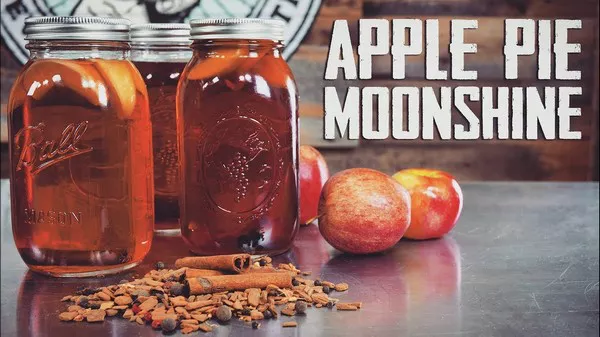In the realm of home distillation, few beverages carry the rustic charm and bold flavors quite like apple cider moonshine. This age-old tradition combines the crisp sweetness of apples with the fiery kick of moonshine, resulting in a drink that’s as versatile as it is potent. In this comprehensive guide, we’ll delve into the art and science of making apple cider moonshine, covering everything from selecting the perfect apples to understanding distillation laws and safety precautions.
Ingredients and Equipment:
1. Types of Apples Best Suited for Cider
When it comes to crafting exceptional cider, the choice of apples plays a pivotal role. Different varieties offer varying levels of sweetness, acidity, and tannins, all of which contribute to the complexity of the final product. Traditional cider apples, such as Kingston Black or Dabinett, are prized for their high tannin content, which adds depth and structure to the brew. However, if these varieties are not readily available, a blend of sweet, tart, and bitter apples can achieve a similar effect. Popular choices include Granny Smith for acidity, Honeycrisp for sweetness, and McIntosh for flavor.
2. Yeast Selection
Selecting the right yeast strain is crucial for successful fermentation and flavor development. Saccharomyces cerevisiae, commonly known as brewer’s yeast, is the go-to option for cider making due to its ability to efficiently convert sugars into alcohol. Within this species, there are various strains, each with its own unique characteristics. For a clean and neutral profile, opt for champagne yeast, while English ale yeast can impart subtle fruity notes. Alternatively, wild or indigenous yeast can lend a distinctive terroir to the cider, though they require careful monitoring to prevent off-flavors.
3. Sugar and Other Additives
Sugar serves as the primary fuel for yeast during fermentation, determining the alcohol content and residual sweetness of the cider. While apples naturally contain sugars, supplemental additions may be necessary to achieve desired potency. Common choices include cane sugar, honey, or maple syrup, though the quantity should be adjusted based on the sweetness of the apples. Additionally, spices such as cinnamon, cloves, or nutmeg can be added to enhance flavor complexity, while fruits like berries or peaches can introduce new dimensions to the brew.
4. Essential Equipment
To embark on your cider-making journey, you’ll need a range of specialized equipment to ensure optimal results:
- Fermentation Vessel: A food-grade container, such as a glass carboy or plastic bucket, to house the cider during fermentation.
- Airlock: A device that allows carbon dioxide to escape while preventing oxygen and contaminants from entering the vessel.
- Hydrometer: A tool for measuring the specific gravity of the cider, indicating the progress of fermentation and potential alcohol content.
- Distillation Apparatus (if legal): In regions where home distillation is permitted, a pot still or reflux still is required for converting fermented cider into moonshine.
- Bottles and Closures: Clean and sterilized bottles for storing the finished moonshine, along with caps or corks to seal them securely.
Step-by-Step Instructions:
1. Preparing the Apple Cider
The first step in making apple cider moonshine is extracting juice from fresh apples. Depending on the quantity, you can use a manual press, electric juicer, or even a blender followed by straining. It’s essential to wash the apples thoroughly and remove any bruised or rotten spots to prevent off-flavors. For a richer flavor profile, consider macerating the apples before pressing to extract maximum juice.
2. Fermentation Process
Once you have obtained the apple juice, transfer it to a sanitized fermentation vessel and add the selected yeast strain. Stir gently to distribute the yeast evenly and attach an airlock to the vessel. Place the vessel in a cool, dark area with consistent temperatures between 60°F to 70°F (15°C to 21°C) to facilitate fermentation. Throughout the process, monitor the cider’s progress by taking regular hydrometer readings and adjusting sugar levels if necessary.
During fermentation, it’s essential to maintain a sterile environment to prevent contamination by unwanted microorganisms. Sanitize all equipment thoroughly before use and avoid introducing foreign substances into the cider. If unusual odors or flavors develop, such as a sulfur-like smell or sour taste, troubleshoot potential issues promptly to salvage the batch.
3. Distillation (If Applicable)
In regions where home distillation is legal, the next step involves converting fermented cider into moonshine through the distillation process. This entails heating the cider in a still apparatus to separate alcohol from water and other impurities. It’s crucial to follow safety precautions meticulously, as distillation involves the use of heat and flammable materials.
Begin by assembling the distillation apparatus according to the manufacturer’s instructions and ensuring all connections are secure. Fill the pot still or reflux column with the fermented cider and gradually heat it to the desired temperature, typically between 173°F to 212°F (78°C to 100°C). As vapor rises through the still, it condenses into liquid form and collects in a receiving vessel, yielding moonshine with a higher alcohol content than the original cider.
Throughout the distillation process, monitor the temperature carefully and discard any initial foreshots or impurities that emerge. Collect the distillate in fractions, known as heads, hearts, and tails, each with varying alcohol concentrations and flavors. The hearts portion is the prized yield, containing the purest and most flavorful alcohol, while the heads and tails can be re-distilled or discarded.
4. Aging and Storage
While apple cider moonshine can be enjoyed fresh off the still, aging it can enhance its flavor and smoothness over time. Transfer the distilled spirit into clean, airtight containers, such as glass jars or oak barrels, and store them in a cool, dark place away from direct sunlight. Allow the moonshine to mature for several weeks to months, periodically sampling it to gauge its progress.
During aging, the spirit undergoes subtle chemical changes as it interacts with the container and oxygen, mellowing harsh flavors and developing complex aromas. If desired, you can experiment with different aging techniques, such as adding oak chips or fruit slices to infuse additional flavors into the moonshine. Once sufficiently aged, the moonshine is ready to be enjoyed responsibly or shared with friends and family.
Safety and Legality:
1. Distillation Laws and Regulations
Before embarking on any distillation endeavor, it’s essential to familiarize yourself with the legalities surrounding home distillation in your region. In many countries, including the United States, Canada, and much of Europe, home distillation for personal consumption is prohibited without proper licensing and permits. Violating these laws can result in hefty fines, legal consequences, and potential safety hazards.
However, there are exceptions in certain regions where home distillation is permitted under specific conditions, such as distilling fuel alcohol or essential oils. It’s crucial to research and adhere to local regulations governing the production and distribution of distilled spirits, ensuring compliance with all applicable laws.
2. Safety Precautions
Distillation poses inherent risks, ranging from fire hazards to chemical exposure, that must be addressed to ensure a safe and successful process. Some key safety precautions to observe include:
- Adequate Ventilation: Ensure proper airflow in the distillation area to prevent the buildup of flammable vapors and fumes.
- Fire Safety: Keep a fire extinguisher nearby and avoid open flames or sparks in the vicinity of the still.
- Personal Protective Equipment: Wear heat-resistant gloves, safety goggles, and protective clothing to minimize the risk of burns or injuries.
- Proper Equipment Maintenance: Regularly inspect and maintain all distillation equipment to prevent leaks, malfunctions, or accidents.
- Responsible Handling: Exercise caution when handling high-proof alcohol, as it is highly flammable and can cause severe burns or intoxication if consumed irresponsibly.
3. Responsible Consumption
While apple cider moonshine is undoubtedly a delightful indulgence, it’s essential to enjoy it responsibly and in moderation. Excessive alcohol consumption can lead to a range of health problems, including liver damage, addiction, and impaired judgment. Always drink responsibly, know your limits, and avoid operating machinery or driving under the influence of alcohol.
Furthermore, be mindful of sharing homemade moonshine with others, particularly if they are not accustomed to its potency. Educate friends and guests about responsible drinking habits and encourage them to savor the flavors of the cider in moderation. By fostering a culture of responsible consumption, we can ensure that everyone enjoys the pleasures of apple cider moonshine safely and responsibly.
Conclusion
In conclusion, crafting apple cider moonshine is a labor of love that combines tradition, craftsmanship, and creativity. By selecting the finest apples, mastering the fermentation process, and observing safety and legal guidelines, you can create a truly exceptional spirit that captures the essence of the autumn harvest. Whether sipped neat, mixed into cocktails, or shared with lov
























